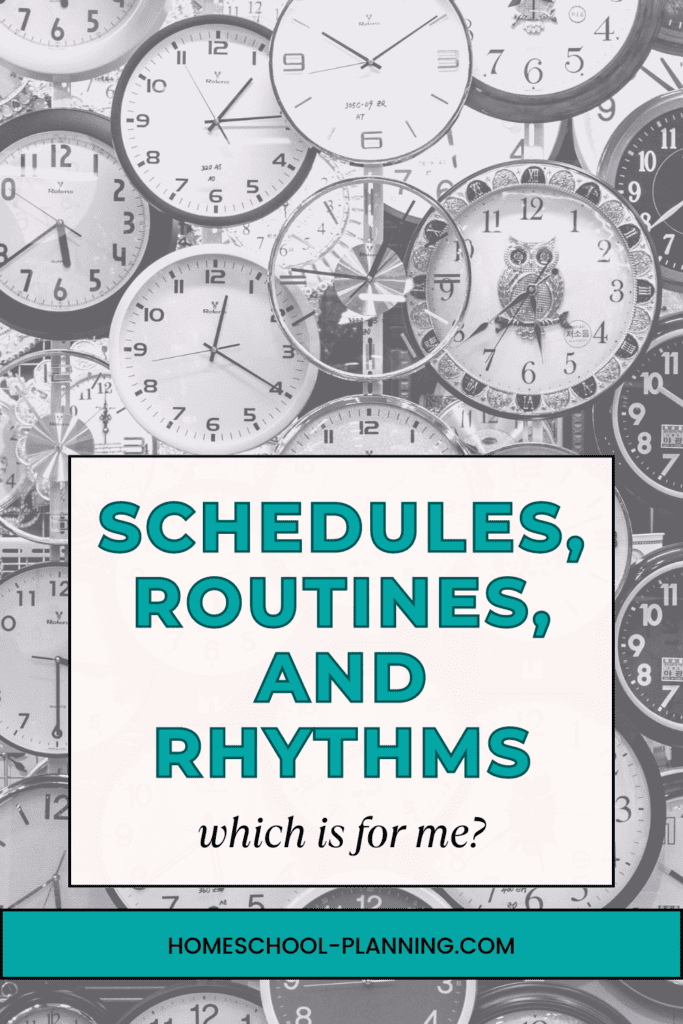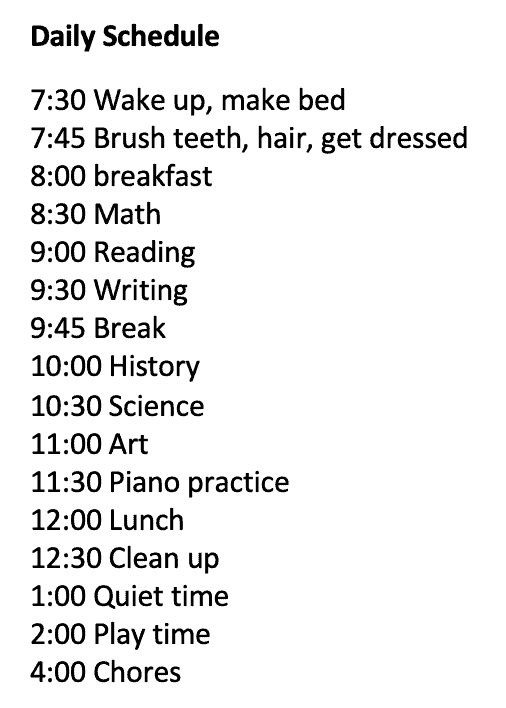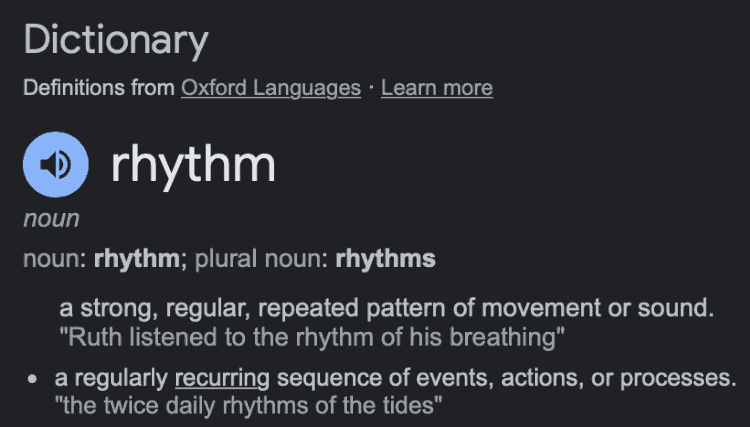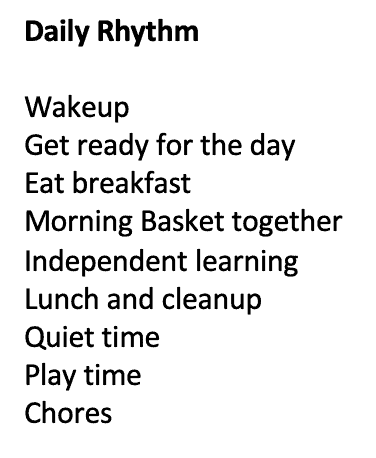The world is full of schedules, routines, and rhythms. From the sun rising and setting each day, to the change of seasons. We wake in the morning and sleep at night. Our bodies function within a rhythm.
You may not consider yourself a very structured person. But I venture to say that everyone follows some sort of rhythm in their lives, even if it’s very fluid. How can we not when it’s everywhere in nature and our surroundings?
I have found the catch comes with the word you use. Some function well with schedules, while others will run from just the mention. But we all have routines we use and a general rhythm to our days. How do we find these patterns and use them to our advantage?
Keep reading as we discuss schedules, routines, and rhythms and how to find your family’s own natural rhythm for your day.

Why does structure matter in our days?
There are many benefits of schedules, routines, and rhythms. Despite the differences in the three, having some sort of predictable structure to your day is helpful, especially to children.
Some of the ways structure can help your days:
- You know what to do next
- Reduces stress
- Predictable
- Helps you get things done
- Reduces decision fatigue
- Calming
- Better time management
- Makes you feel secure
- Helps you meet your goals

What is a schedule?
Many run from the mention of a schedule, while others embrace it. The word is also overused and even misused to mean something it is not. It is often used to describe any sort of ordered structure to your day or year, no matter whether times are attached or not.
Google defines schedule as “a plan for carrying out a process or procedure, giving lists of intended events and times.” You may also hear it called a timetable.
So in a little simpler way, a schedule for your day would be the list of things you plan to do with the times you will do them. The key here is a schedule is bound by time.
If you have a schedule for your day, then all of your time will be allotted in your daily schedule, item by item and minute by minute. Many may find this idea confining but loose schedules are possible as well.
A schedule is also easily changeable from day to day as it is not in its basic form dependent on the order things are done.
A sample daily schedule


What is a daily routine?
A daily routine is a list of tasks usually done in a certain order, perhaps at a certain time. It is generally unchanging. Google defines routine as “a sequence of actions regularly followed; a fixed program.”
Routines are not greatly associated with time, but often attached to larger habits or tasks. In a routine, you would do one thing followed by another, followed by another. You will do this list of items in the same order every time.
So it’s generally a small group of tasks that work together to accomplish a larger goal. Like getting your kids ready for bed, you may have a bedtime routine where you brush teeth, then read a story, then kiss them goodnight.
Sample daily routines


What is a daily rhythm?
A daily rhythm is a term often used in the Montessori world and with small children to represent the pattern or flow of your day. It’s not really associated with time, but focuses more on the list of major tasks within your day. Rhythms tend to be fairly flexible and allow for spontaneity, but generally follow the same order. each day.
Rhythms also seem to portray a sense of ease where you might “float through your day” rather than a tool to use to squeeze more in. This doesn’t mean you don’t get things done, but rather do what you can with ease.
Google confirms this with its definition of rhythm as “a strong, regular, repeated pattern of movement or sound.” or a “regularly recurring sequence of events, actions, or processes.”
A sample daily rhythm

What is routine vs rhythm?
Routines and rhythms seem to be similar in many ways. But I have found that a routine is more specific while a rhythm is more of an overview. Routine often applies more toward the order of small habits and tasks, while a rhythm is a general flow of larger tasks, like your whole day.
A rhythm also has a stronger focus not only on the tasks and order of things you do, but the attitude you have in doing them. The general ebb and flow of your day. It’s gentle and allows for flex.
A routine is simply an order of things you do and can easily be included into your daily rhythm. For instance, you might start your daily rhythm with your morning routine. The routine is specific and the rhythm is more like the framework the routine fits into.

Is there a difference between routine and schedule?
The big difference between routine and schedule is that a schedule is largely associated with time frames. You do something at a certain time and complete it at another. A routine is more about the order of tasks, no matter when they are done. Routines are done the same way every time.
Though routines are often used in relation to a certain task at a certain time, each item is not generally timed. But routines can be easily included within a schedule.
For instance, you could say at 8:00 we will start our bedtime routine. The schedule is the routine from 8-8:30. The routine is a list of what you do within that timeframe in your schedule.

Which is for me?
You may think that schedules and structure is not for you. But then you had kids and everything flew out the window. Or maybe you used to be so structured but kids have not allowed you to be anymore. Each family will have their own needs and ways of doing things at any given season of life.
So how do you know what your family does? Ultimately, you should observe your family and daily habits. It’s quite difficult to force yourself and others into a way of being that is unnatural, so start with your natural inclinations.
Read: How to Set a Schedule Using Your Natural Daily Rhythms
If your family easily wakes up at a set time each day and thrives on time limits and set boundaries, then a more set schedule might work for you. You can allot time for every item and know when to move on.
If nothing ever seems to happen at the same time and you function well with more of a general flow to your day, then setting a general rhythm to your day may be helpful.
If you like to capture order and develop strong habits within the sections of your day, then establishing routines may be what you need. And these can easily be used in combination with other structures.
All of these things are helpful, and none is better than another. We all thrive on different degrees of structure. And don’t be afraid to mix and match and make it yours.
No matter how you do it, the act of adding structure to your days will be helpful. All you have to do is decide on what you will do in advance, and the general order you will do it in. You can be as detailed or general as you need.

Keep it flexible
One thing that is important with any type of structure in your day is that you keep it flexible. Not every schedule has to be detailed, scheduling every single task. And not every rhythm has to be loose and general.
Read: How to Have a Flexible Homeschool Schedule
Having built-in flexibility will help you stick to the structure you use. Two of the best ways you can accomplish this flexibility is to build in extra time and use general time blocks in your day.
Add margin into your schedule for the times when math is hard and takes a long time, when the toddler is a mess, and when you get an unexpected phone call from your mother-in-law. You could have some free time in your schedule to use as overflow, or have extra time allotted for each task.
I have also found it helpful to use general time blocks rather than using a detailed schedule or rhythm. Listing school as a 2 hour block in your schedule, rather than saying math for 30 minutes, followed by reading, etc.
You could still list your school routine within that block if desired, but using larger blocks of time will allow more freedom to flex as needed within each subject in your routine.
For more ideas on adding flexibility to your homeschool, check out my post about flexible homeschool schedules here.

How to find your own daily rhythm
Perhaps you have no idea where to start to establish routines, rhythms, and schedules into your homeschool day. Here are some tips.
- Observe your day – Spend a few days going through what you as a family normally do. But observe what you do and how you do it.
- Capture what happens – Write down your typical rhythm and routines, and capture the trends on paper.
- Listen to good input – Talk with those you trust about ideas for what your day could look like. Spouse, friends, or a mentor.
- Trust your instincts – Trust your gut when it comes to your family and your schedule. Your thoughts are important.
- Create routines – It may be done for you out of habit, but encourage routines within your day. Write them down.
- Practice your rhythm – Work through what you have at this point and practice with new routines.
- Make small changes – Start with what you already do and make small changes till it works. Add new things slowly. Small changes will stick better than an overhaul.
- Evaluate often – When you feel like something isn’t working well, evaluate how it could be better and make a small change.
To read more on finding your natural daily rhythm, check out my post on using your natural daily rhythm to make your schedule here.
Schedules, routines, and rhythms
Schedules, routines, and rhythms are all helpful aspects of structuring your day. Whether you like to have things set with times, or if you you’d rather just flow through your day. Adding some sort of framework will help bring predictability and a sense of accomplishment for any homeschool family.
Be sure to find what works for your family and make it your own. Keep it flexible and you will stick with it.
Which way of structuring your day seems to work for your family? Tell me more in the comments.
Related Posts
Using your natural daily rhythm to make your schedule
Plan your year with free printable homeschool attendance sheets










